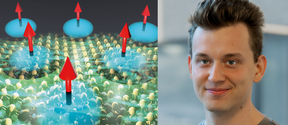A simple method developed for 3D bio-fabrication based on bacterial cellulose
Bacterial cellulose bio-fabricated in the shape of an ear via superhydrophobized molding. Photo: Luiz G. Greca
Bacterial cellulose (BC) nanofibers are promising building blocks for the development of sustainable materials with the potential to outperform conventional synthetic materials. BC, one of the purest forms of nanocellulose, is produced at the interface between the culture medium and air, where the aerobic bacteria have access to oxygen. Biocompatibility, biodegradability, high thermal stability and mechanical strength are some of the unique properties that facilitate BC adoption in food, cosmetics and biomedical applications including tissue regeneration, implants, wound dressing, burn treatment and artificial blood vessels.
In the study published in Materials Horizons researchers at Aalto University have developed a simple and customizable process that uses superhydrophobic interfaces to finely engineer the bacteria access to oxygen in three dimensions and in multiple length scales, resulting in hollow, seamless, nanocellulose-based pre-determined objects.
“The developed process is an easy and accessible platform for 3D biofabrication that we demonstrated for the synthesis of geometries with excellent fidelity. Fabrication of hollow and complex objects was made possible. Interesting functions were enabled via multi-compartmentalization and encapsulation. For example, we tested in situ loading of functional particles or enzymes with metal organic frameworks, metal nanoparticles with plasmon adsorption, and capsule-in-capsule systems with thermal and chemical resistance”, explains Professor Orlando Rojas.
This facilitated biofabrication can be explored in new ways by the biomedical field through scaffolding of artificial organs. Advances in bioengineering, for instance by genome editing or co-culture of microorganisms, might also allow further progress towards the simplified formation of composite materials of highly controlled composition, properties and functions.
Further information:
Professor Orlando Rojas
Aalto University
[email protected]
+358 50 5124 227
Article:
Luiz G. Greca, Janika Lehtonen, Blaise L. Tardy, Jiaqi Guoa and Orlando J. Rojas, Biofabrication of multifunctional nanocellulosic 3D structures: a facile and customizable route
Materials Horizons 2018, Advance Article
DOI: 10.1039/C7MH01139C
http://dx.doi.org/10.1039/C7MH01139C
- Published:
- Updated:
Read more news

Find our doctoral community at Aalto Social
Follow the posts, share and discuss anything related to doctoral education at Aalto Social.Aalto computer scientists in CHI 2024
Multiple papers from Aalto CS were accepted to the CHI 2024 conference
"Keep an open mind and step outside of your comfort zone"
Read what double award winner Kukka-Emilia Huhtinen wants to share about her doctoral studies in theoretical physics